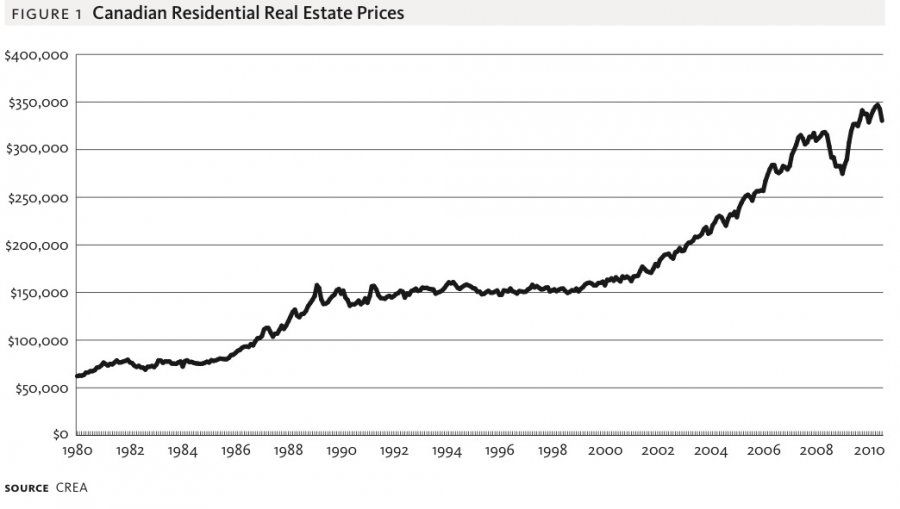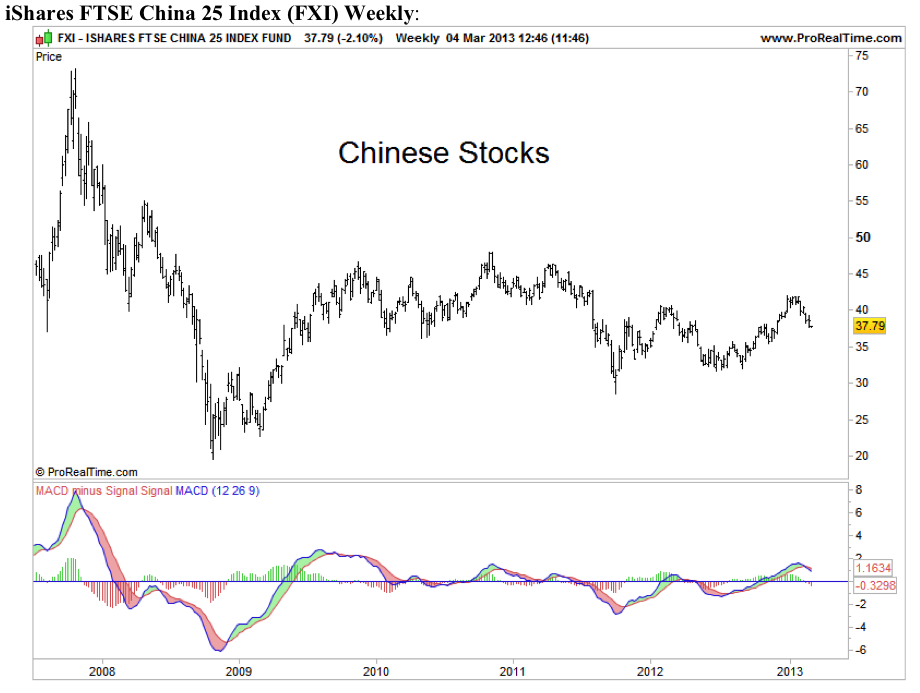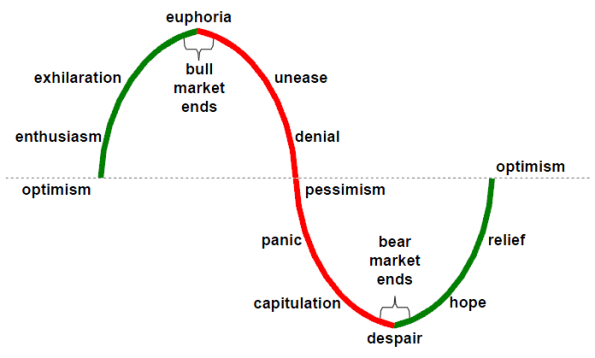Personal Finance
Dow up 125 points yesterday, to a new all-time record.
Why? What’s behind it? The economy is not so hot. Why the red-hot stock market?
China is back in the news. A new report from CBS’s “60 Minutes” documents the extent of the ghost cities in China — miles and miles of empty highway, office towers, apartments and malls. Analysts are talking about the biggest real estate bubble in history!
Is China a bubble? We don’t know.
Does it matter? Well… yes… maybe. If China melts down or blows up the demand for oil and other resources goes down. The Chinese have pumped vast sums of money into development projects. That money helped to keep people on the job… and also kept the ships full of stuff, going back and forth across the world’s oceans.
Trouble in China is trouble everywhere — particularly in Australia (which has been selling itself by the ton to the Chinese) and in Europe (which sells its precious, high-touch products by the boatload). Drive around Beijing and you see German autos, Italian shoes, Swiss watches and French perfumes.
But why worry? The Chinese can print money too! When China does something, it tends to do it to excess. That’s why there are so many empty buildings in the Middle Kingdom and why it might have created the biggest real estate bubble in history.
China overdoes it when it comes to central bank stimulus measures too. Arguably, no central bank has done more than the People’s Bank of China when it comes to pumping up the economy.
M2 money supply in China is roughly twice GDP. In developed economies the ratio between M2 and GDP is usually below one. In emerging market countries, M2 is usually 1 to 1.5 times GPD.
That’s why bad news for China… like bad news for the U.S. economy… could be good news for the stocks. The Chinese feds will pump more money. Stocks will go up!
The New York Times reports:
The Dow Jones industrial average, which measures the performance of 30 blue-chip companies, closed with a gain of more than 125 points Tuesday, surpassing its previous record close of 14,164.53, which it achieved nearly five and a half years ago, as well as its record intraday high, set around the same time, of 14,198.10.
Of course, a few things have happened since October 2007. The housing market collapsed, the financial system went into meltdown, the European Union started to fray and politicians dragged the United States through an on-off-on-again fiscal imbroglio.
But stocks managed to move beyond all that.
Since a low point in March 2009, the Dow Jones index has more than doubled, stunning even the most seasoned stock market watchers. It closed at 14,253.77 Tuesday.
“What’s amazing about this bull market is that people still don’t think it’s real,” said Richard Bernstein, chief executive of Richard Bernstein Advisors, a money management firm. “We think this could be the biggest bull market of our careers.”
The Aristotelian Error
Yeah — you can count us among those who don’t think it’s real. We think it’s what happens when all the world’s central banks are evaporating yields on bonds and corralling investors into stocks.
If China goes into a serious correction, how will its leaders overreact? With even more funny money and EZ credit?
We don’t know enough about the Chinese situation to make an educated guess. So we’ll make an uneducated one. Whether they live in Beijing or Washington, economists tend to have the same dumb ideas.
They are heirs to the Aristotelian error: the belief that without them the whole world will fall to pieces. They believe they must set the price of the economy’s most essential ingredient: credit. And if the economy fails to do their bidding, they will give it more money too.
All major central banks are in agreement about this. All believe they can see, in their mind’s eye today, a picture of the world as it will be tomorrow. And they further believe that they can Photoshop it to make it better.
They improve the future by making credit cheaper or dearer, as the occasion requires.
But how is it possible, you might wonder, that these few homo sapiens can do something so remarkable?
How do they know precisely how much new money to create and how to price it? What kind of bread do they eat? What kind of liquor do they drink? Surely, they do not eat and drink the same things we do; for they must sup at the gods’ table to be able to do such things.
In their naïve and simpleminded way, the planners believe that a slack economy calls for overtime work at the central bank. That which the private sector taketh away, they say, is what we will put back — and more!
So stocks go up. That’s our best explanation.
Regards,
![]()
Bill

Bill Bonner started Diary of a Rogue Economist to share his over 30 years of economics and market experience with as many interested readers as possible.
Diary of a Rogue Economist is always free, and it’s delivered to your email each business day.

Canadian home prices mirrored those in the U.S. as they surged from 2001 to 2008, then plunged during the global financial crisis. Since 2009, however, they have once again been on a tear as U.S. home price have remained subdued.

What follows is a review of how the Canadian housing market has evolved since 2001. It should be noted that Carney took over the Bank of Canada in 2007.
……read it all HERE
also see:
The top 15 US cities are ranked by the projected annualized change in home prices between Q3 2012 and Q3 2017 – HERE
&
The World’s #1 Housing Market Is Ridiculous Again – HERE

….then it may not be too early to sell Chinese stocks.
Quotable
 “By three methods we may learn wisdom: First, by reflection, which is noblest; Second, by imitation, which is easiest; and third by experience, which is the bitterest.” – Confucious
“By three methods we may learn wisdom: First, by reflection, which is noblest; Second, by imitation, which is easiest; and third by experience, which is the bitterest.” – Confucious
Commentary & Analysis
If it’s the “largest real estate bubble in human history” then it may not be too early to sell Chinese stocks.
“It [China] may have created the largest real estate bubble in human history,” was the introduction by Lesley Stahl of 60-minutes to a story about China’s real estate bubble. If you missed this story, I suggest you take time and watch it. You can find it here. After viewing this, and seeing the miles and miles and miles of empty skyscrapers, condos, and shopping centers, it is highly probable China has created the large real estate bubble in human history.
Lesley kept quoting from one of baseball’s classic movies, Field of Dreams(though JR and I prefer The Natural), “If we build it they will come,” as the rationale for all this space. But as you learn right away in the 60-minutes piece-they aren’t coming. There has been no mass migration from the rural areas to these new cities. And just maybe, as an analyst quoted in the piece said, it might be because most of the housing built in these gleaming new ghost cities is priced at about $50,000 US per unit and peasants make about $2 per day on average.
“It [China] may have created the largest real estate bubble in human history,” was the introduction by Lesley Stahl of 60-minutes to a story about China’s real estate bubble. If you missed this story, I suggest you take time and watch it. You can find it here. After viewing this, and seeing the miles and miles and miles of empty skyscrapers, condos, and shopping centers, it is highly probable China has created the large real estate bubble in human history.
Lesley kept quoting from one of baseball’s classic movies, Field of Dreams (though JR and I prefer The Natural), “If we build it they will come,” as the rationale for all this space. But as you learn right away in the 60-minutes piece—they aren’t coming. There has been no mass migration from the rural areas to these new cities. And just maybe, as an analyst quoted in the piece said, it might be because most of the housing built in these gleaming new ghost cities is priced at about $50,000 US per unit and peasants make about $2 per day on average.
Three takeaways here for me were: 1) When the migrant workers start to leave the building projects, “it is an early warning” that the debt crisis is about to begin, and the migrant workers are leaving, 2) A break in the bubble could wipe away “three generations of savings” by Chinese citizens, and 3) if the bubble pops it could spark an “Arab Spring” in China.
Yikes! Is it any wonder why Chinese leaders wish to keep the islands in the East China Sea and Japan on the front burner?
Though stock markets in most places have enjoyed heady gains the last few years—not China. This excerpt comes from an article by Edward Chancellor, “Consistency in a topsy turvy world,” appearing in today’s Financial Times:
“The mean reversion of stock market returns and returns on equity are one and the same.
“The performance of equities in less capitalistic economies seems to support this point.
“China is the most striking anomaly. Despite economic growth in double digits over the past two decades, Chinese equities have delivered an annual real return of -2.5 per cent in local currency since the early 1990s, according to the authors of the Credit Suisse Global Investment Returns Yearbook. The Chinese stock market is dominated by state-owned enterprises whose capital allocation is ultimately decided by government. Some studies suggest these businesses earn negative returns on capital once subsidies are taken into account.”
“The lesson of history is clear. Unless factories have been bombed or the country is being run by crooks or, even worse, by Communists, mean reversion is one of the few constants in an every changing investment world.”
In the eyes of Michael Pettis, a finance professor at Peking University, and a very brilliant macro strategist, China may indeed be entering the danger zone; this tends to dovetail on what Mr. Chancellor was saying [Mr. Pettis’ latest missive is a brilliant read if you have time]:
“In analyzing China’s growth in the past three decades we seem to forget that there have been many growth ‘miracles’ in the past two hundred years. Some have been sustainable and have led to developed country status but many, if not most, were ultimately unsustainable. Nearly all of the various versions have had some similar characteristics – most obviously infant industry protection, state-led investment in infrastructure, and a financial system that disproportionately favored producers at the expense of savers – but the way these characteristics played out were very different, in large part because the institutional structure of the economy and the financial sector created a very different set of incentives.”
Using the three key elements of the American System and historical development as a guide..
- infant industry tariffs
- internal improvements,
- and a sound system of national finance
…and contrasting this against China’s development, Mr. Pettis says:
“…the historical precedents should worry us. In most cases they suggest that China has a very difficult adjustment ahead of it and the closest parallels to its decades of miracle growth suggest unfavorable outcomes.”
Let’s count a break in the real estate bubble as being at the top of the list if it wasn’t already.

- Jack Crooks
- Black Swan Capital
- www.blackswantrading.com
- info@blackswantrading.com
- Ph: 772-349-6883

 “The market is very schizophrenic. However it is possible to follow only a mild (Stock Market -Ed) correction in February, after which the growth to continue.”
“The market is very schizophrenic. However it is possible to follow only a mild (Stock Market -Ed) correction in February, after which the growth to continue.”
“In this situation sell. Restrict positions because euphoria gaining strength.”
“Corporate profits are likely to disappoint this year. Incidentally, there may be geopolitical problems” said Faber, adding that recently returned from a trip to the Middle East, which is the “melting pot.”
Oil demand will be strong
Faber – 2013 Gold Price Prediction
(Faber has 25% of his assets in Gold- Ed)
Marc Faber in a recent interview discussing his predictions and outlook for 2013 regarding gold and silver prices. I have some concerns about confiscation especially in the united states Faber said ” I have argued for the last 12 years that investors should buy a little bit of physical gold every month and put it aside without concerns about corrections. If you don’t own any gold, I would start buying some right away, keeping in mind that it could go down. For the last 40 years in my business I’ve seen people always lose money when they put too much money into something and then it goes down. They panic and sell, or they have a margin call to sell—and lose money. I own gold. It’s my biggest position in my life. The possibility of the gold price going down doesn’t disturb me. Every bull market has corrections.” Marc Faber said in another interview regarding owning Gold

 The Buying Power, and Selling Pressure, indicators continue to suggest no major “top” is in the works. Ditto the Advance/Decline line traded to a new high before the mid-week pullback, also confirming the upside. The major averages continue to reside above their respect 50-DMAs and 200-DMAs; and, those moving averages are rising, another bullish sign.
The Buying Power, and Selling Pressure, indicators continue to suggest no major “top” is in the works. Ditto the Advance/Decline line traded to a new high before the mid-week pullback, also confirming the upside. The major averages continue to reside above their respect 50-DMAs and 200-DMAs; and, those moving averages are rising, another bullish sign.
Then there is Berkshire Hathaway (BRK.A/$152,009/Not Covered), which is somewhat of a proxy for the stock market, as it traded to a new all-time last Friday. That said, last Wednesday proved to be a 90% Downside Day suggestive of at least a pause, or perhaps a pullback. Still, with Friday’s rally the “buying stampede” remains in force and today is session 38. Friday’s Fling, however, felt more like a recoil rally rather than the beginning of a new rally leg, at least to me.












